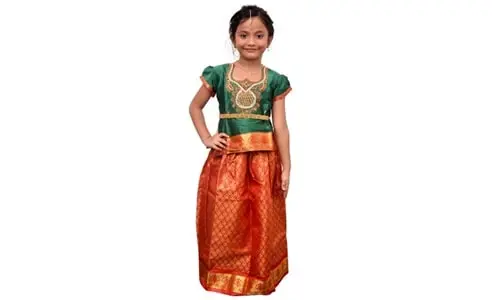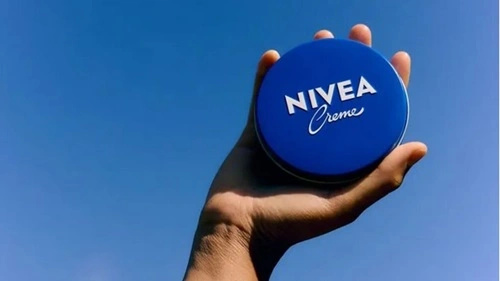Tamil Nadu is a popular state in the South of India. It is famous for its rich culture and beautiful temples. Traditional dresses of Tamil Nadu symbolize its diversity and cultural essence. Exclusive high-end fabrics like silk, crepe silk, georgette, cotton, chiffon, pattola silk, organza, and micro silk are used in the dress material. Let’s dive in and find out more about the traditional attires for both men and Women in Tamil Nadu.
Traditional Dresses of Tamil Women
1. Pavadais

Pavadais are a special kind of long skirt worn by young girls in Tamil Nadu. They are made of cotton and paired with a short blouse. Pavadais are worn during family functions and special occasions. They are a pure symbol of elegance, simplicity, comfort, innocence, and purity.
2. Kanchipuram sarees
Sarees are the epitome of beauty for women nationwide. However, the style, color, and design vary from region to region. The length of the sarees is up to 5 yards to 6 yards. Kanchipuram sarees are a well-known specialty of Tamil Nadu. They are traditional handwoven sarees made with specialized threads and motifs. The excellent craftsmanship is illustrated in this stunning saree design and patterns. Kanchipuram sarees are costly and usually worn at weddings, festivals, and grand ceremonies. A notable draping saree known as the Madisar saree signifies married women. These sarees are worn during auspicious occasions.
3. Salwar Kameez
Salwar Kameez is a part of daily attire in Tamil Nadu. It consists of a tunic long-top kameez paired with a loosely fitted pajama known as kameez. This combination is adorned with a matching dupatta. It serves in both formal and casual environments.
Traditional Dresses of Tamil Men
1. Veshti (Lungis)
Veshti are world-famous traditional attire worn by every South Indian man. However, the color and patterns differ from those of the northern states of India. In south India, the Veshtis are white or cream with golden borders and worn with shirts of any color. It can also be paired with a short kurta. The fabric used is mainly cotton to enable a comfortable feel. It is worn as casual attire and for different festive occasions.
2. Angavastra
Angavastra is immensely important in Tamilian culture and is used during poojas and marriages. It is a long piece of cloth similar to lungi. Angvastra is used to cover the shoulders during festive occasions. The cotton or silk fabric comes in different colors and patterns. It symbolizes grace and elegance and offers immense respect for those who wear them. People have recently started using Angavastra on shirts to cover one side of the shoulder.
3. Silky shirts
Tamil Nadu men love wearing silk shirts. These shirts are short with long or short sleeves. They are easy to carry and feel smooth on the skin. Moreover, they are available in numerous color combinations and are made of fine-quality silk. They are also unique in terms of fabric. Silk shirts in Tamil Nadu differ from regular shirts in other Indian states.
Traditional accessories of Tamilian women
Any traditional dress is complete with a touch of finely polished jewelry. Tamilians love ornaments made out of pure gold. Here are a few of their traditional jewels.
1. Vanki
Vanki is a unique armlet worn by brides and dancers in Tamil Nadu. This armlet is crafted out of pure silver or gold and contains expensive motifs and gemstones embedded in it. Vanki symbolizes feminine power and ancestral jewelry passed on from generation.
2. Mangamalai
Mangamalai is a mango mala adorned by Tamilians for ages. It consists of mango-plated designs made of pure gold. The necklace features black beads with mango-shaped pendant at the bottom. Mangamalai is a symbol of prosperity, charm, royalty, and happiness.
Conclusion
The traditional dresses of Tamil Nadu are directly connected to the roots of the state. They denote the cultural values and lifestyle of the state. Whether it is men or women, the cultural outfits look wonderful to both men and women. Besides the Kanchipuram, a highly graded silk made out of Kanchipuram silks only, this traditional attire has been kept alive for the past 150 years and is purely handwoven without using any specialized machinery.

